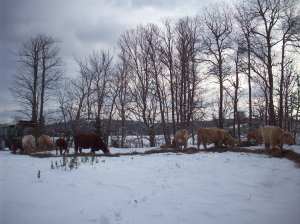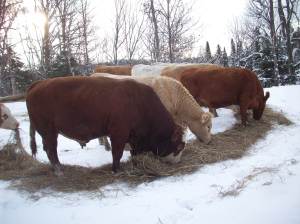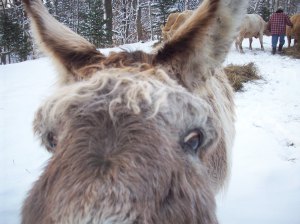For the uninitiated listening to an auctioneer can be difficult and confusing, but to most livestock farmers it is common fare, and very important. 2014 has seen record high prices for beef cattle and I am sure you have noticed the result at the meat counter. Our beef calves born in April – May and sold early November on average sold at 40% more than last year. But, like the other “stock” market, both luck and good management are required to succeed. Let me take you on a trip to the livestock auction.
Most farmers in our region selling live cattle sell at Ottawa Livestock Exchange located in Leitrim, just off Back Street South. Sales are held Monday for sheep, pigs, and dairy cow replacements and Thursday for beef cows, yearlings, and calves and cull dairy cows and bulls. Hundreds of cattle arrive by truck during the morning, are tagged and go to group pens to await the sale which starts at noon. Two auction rings are in operation. One ring sells mature cows and bulls; another ring sells cattle under about 18 months and 1000 pounds.
Now this is where it gets interesting. There may be 20 to 40 people sitting in the auction ring, but how many are famers (sellers) and how many are order-buyers. Order buyers are the professionals who make their living, 52 weeks a year buying cattle for feedlots or packers. So the regular “Joe Farmers” may buy a couple of head at a time, but the order buyers might be simultaneously buying for 3 or 4 clients, each wanting a truckload or more at a time. It is the old story of supply and demand, the more buyers the better. An individual or group of animals is in the ring for only 30 to 45 seconds, so the buyer has to know what he is doing, and quickly decide if this 500 lb calf is worth $1.75 or $2.85 per pound, or total price of $875 versus $1425.
So what is the difference between a $1.75 calf and a cream of the crop one worth $2.85 per pound? Principal requirement is good confirmation, a big frame on which to grow meat. But poor confirmation is not the only thing which can lower the price; a male calf not castrated = discount, a calf with horns = discount, certain breeds = discount. In reality there are many, many things which drag down the price. Since many of our cows go to a packer in Pennsylvania, this week the Buffalo snow storms are creating a drag on prices. You get the picture…. another one you would not believe, female calves always sell for less than males. Yes females may yield a little less meat per carcass, but did you ever go to the supermarket and get a deal because the beef you are buying is from a female instead of a male. Just like the price of a women’s haircut versus a man’s, it may not make sense, but it is one of those wacky things in the market place.
So raising cattle may seem simple, just like monopoly, buy cows, raise calves, sell calves, pass Go and go directly to the bank. But like any real business, (and monopoly) it can be a roll of the dice, and the more you learn the more you realize you don’t know. The beef business is anything but dull and another week I will try to explain why you are paying so much more for beef this year.
And yes I am smiling this week, because we did sell some of those cream of the crop calves for $2.80 per pound. Until next time…
Bob
Winter sky in the morning
Cows heading to breakfast
Round bales are rolled out to provide lots of space for all to eat
Bull and friends enjoy breakfast
So where is my treat?






Thanks for the insight into farming in Canada. I had no idea that there were cattle auctions on Leitrim.